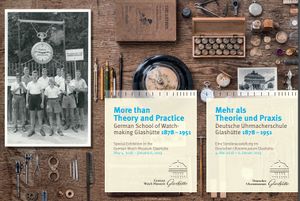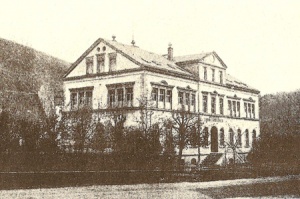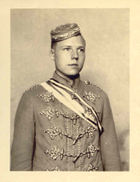Special Exhibition "More than Theory and Practice"


Deutschen Uhrmacherschule Glashütte (German School of Watchmaking Glashütte)
Special Exhibition "More than Theory and Practice"
From May 4, 2018 to January 6, 2019, visitors can find out more about the time of the historical German School of Watchmaking Glashütte with unique students’ works, numerous original documents and interactive stations in a special exhibition.
Historical Background:
Following the unification of Germany in 1871, numerous all-German institutions came into being in the German Empire. The formation of a central School of Watchmaking was a top priority for the Society of German Watchmakers at their first congress in 1876. The watchmaker Moritz Großmann suggested Glashütte as the location. A small Saxon town in the Ore Mountains that was already established as a production and education center for precise watchmaking. In addition to specialist expertise, geographical and social advantages were important for the decision. On 1th May, 1878, the German School of Watchmaking Glashütte was ceremonially opened in Glashütte. Due to the steadily growing number of students, an own building for the watchmaking school was already inaugurated in 1881. During the following years, several structural expansions took place to meet the requirements of the changing conditions in the education and the student body. The extension building from 1923 was a milestone in the architectural history and is still an impressive entrance to the building today. During the school’s 73-year history more than 2,500 students from 37 countries attended the school for an education or a training in the watchmaking art and the precision mechanics. The excellent education offered many perspectives: Some former students became self-employed watchmakers, took over executive jobs in renowned watch companies, founded own brands, sold Glashütte time pieces as concessionaires or worked as teachers. They made the name “Glashütte” famous throughout the whole world and helped to increase the success and the publicity of the Saxon competence center for mechanical watchmaking. The change of the pedagogical concept and the rename of the school into “Specialist School for Precision Mechanics and Horology” in 1951 effected the end of the era of the German School of Watchmaking Glashütte. In the year 2008, the way for a new future of the building was paved. Along with the German Watch Museum Glashütte the “Alfred Helwig School of Watchmaking”, run by the manufactory Glashütte Original, has been located within the historic walls and brings back the apprenticeship.
Special Exhibition:

The focus of the exhibition “More than Theory and Practice” is the life of the students, teachers and headmasters at the watchmaking school through the ages. What was it like to become a watchmaker more than 100 years ago? How did they learn this profession without any electricity, any machines and computer; in a valley far away? How did the students feel about their time at the watchmaking school in Glashütte? What thoughts came to their mind while remembering their time in the “muse town”? On the basis of unique student works such as pocket and wrist watches, pendulum clocks, marine chronometers, escapement models, precision instruments, drawings, documents of contemporary witnesses and multimedia stations the visitor can take the plunge into the time between 1878 and 1951 and discover why the time at the school has been so much more than theory and practice studies.
A bilingual exhibition catalogue “German School of Watchmaking Glashütte” is available in the museum and the online shop.
*Brochure Special Exhibition "More than Theory and Practice"